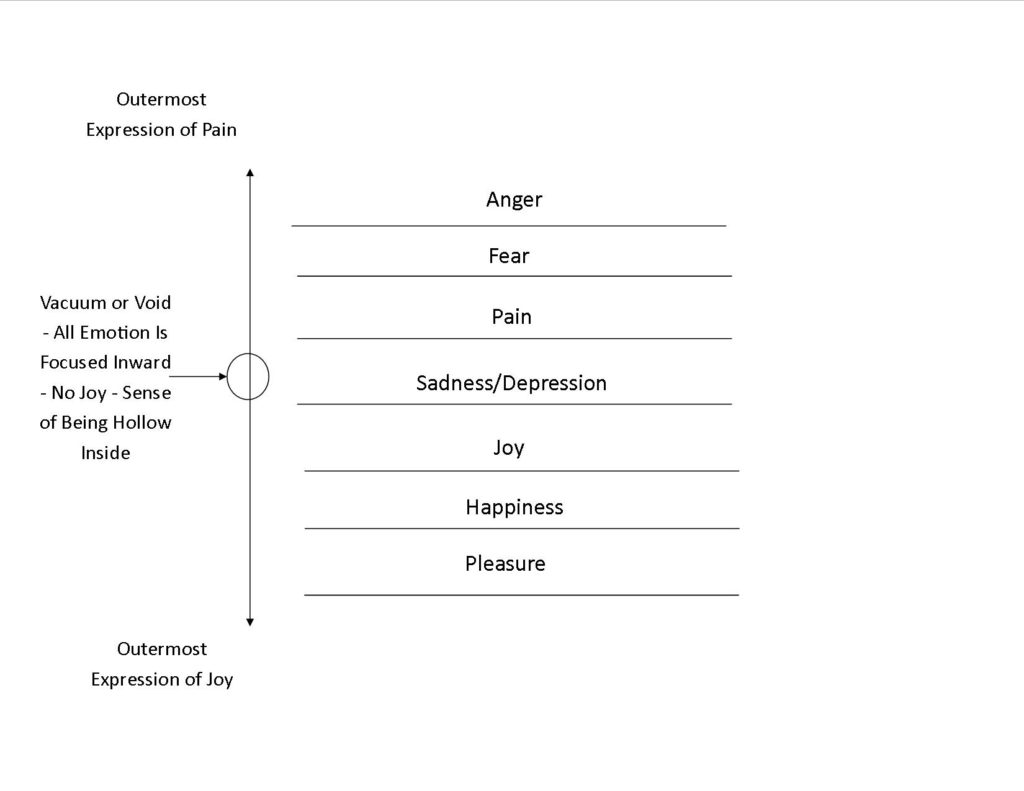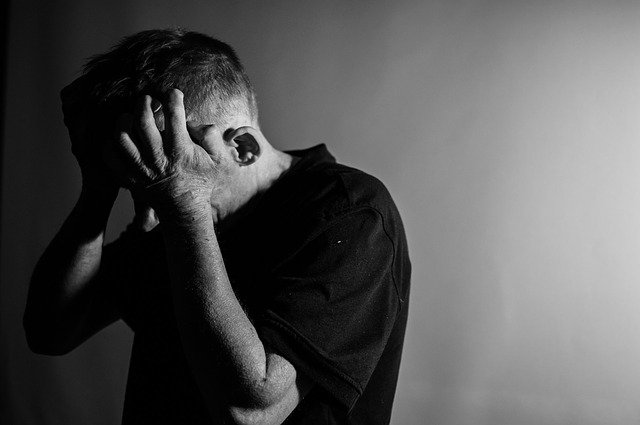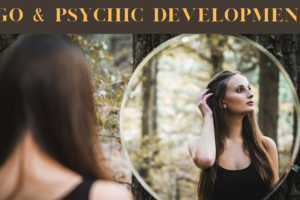On Wednesday evening December 9th, I received another inspired lesson that I knew was intended to be an important message. These insights are often a part of my work and something I’m still trying to get organized into an upcoming book, but when motivated, I share bits of them in a post.
The topic of Wednesday’s lesson was entitled “The States of Being,” and it addressed the nature of our human emotional spectrum. While we would think that our human emotions would naturally focus on love versus hate, surprisingly the message was more complicated than that. So let me start by sharing a snippet of that lesson by showing the below diagram.

I’m not going to get into the numerous specifics of the ‘States of Being’ lesson in this post. For now, we just need to see this diagram and look at the range of emotions that are identified. What you will notice is that none of them are about love or hate.
You see, we think that love and hate are at the opposing ends of the emotional spectrum but actually this really isn’t quite the case. Now, I’m not negating that hate exists in the world or that love is the most powerful force there is. This isn’t the point – yet! What we really see in these layers of emotions shown in the diagram above is a spectrum of experiences that we typically ‘label’ as either good or bad, but the truth is, these emotions aren’t good or bad – they just are what they are.
For example, there are times when fear and anger are powerful positive forces for personal or even societal change, just as happiness & pleasure utilized in negative ways can lead to personal addictions and outside sources for fulfillment. In this way, the emotions themselves are just that – emotions. We will experience all of them as a result of being alive. None of them are good or bad – both have gifts and both have pitfalls. And yes I agree that pain, fear, and anger are typically unpleasant, but this is where the real lesson begins.
In the middle of the night, after I had typed up the nature of this emotional spectrum, I was given the additional message of, “We can’t heal from a place of hate.”
So what does this mean in the context of the above spectrum of emotions?
First, that only from a place of love can we grow, heal, expand, and live our life.
Pretty simple right?
Well, let’s take this a step further and really examine what this means.
If we know we can’t heal from a place of hate and we know we need to have love, then doesn’t this mean that we will only heal when we eradicate anger, fear, and pain and replace it with love? Well, yes it does to some extent, but here’s the bigger secret in this lesson.
You have to LOVE all your emotions – even your anger, fear, and pain!
Yes, you heard me right.
You need to love every emotion, not just the ones you deem positive because they are all positive. It’s just that some hurt more than others.
If you hope to eradicate anger, fear, and pain, then how does hating these emotions create any form of healing?
Typically when we are in a state of hate we are rejecting something, being angry with it, and despising it. But what if, instead, we loved our anger, fear, and pain?
What if we said, “Thank you for this suffering because I know it has gifts for me. I welcome learning from this so that I can move from a place of suffering to a place of healing?”
Not to mention, when we love and embrace all our emotions and feelings, we no longer need to take them out on others because we can now embrace them as our own. We become accountable and can stop laying blame. We must embrace that we are angry. We must embrace that we are afraid, and we must embrace that we are angry and afraid because we have been hurt and are in pain. We need to embrace that we may be seeking joy and happiness through others or through pleasurable addictions that are only destructive.
When we hate our anger, fear, and pain we are rejecting our feelings, but how can we reject something that is a very real part of our human existence? This is to hate ourselves, or even worse, to blame others for the experience of these emotions in our lives – hating whatever it is that is the perceived cause of our suffering.
We cannot heal from a place of hate!
We must embrace all of our human emotions, even the painful ones, and love them and give gratitude for their gifts.
And please know, I don’t stand before you with a holier than thou attitude. I know this is not easy and I am learning from these lessons right alongside you.
For example, I have had a wide range of chronic issues that have left me feeling angry and bitter and cheated out of over a decade of my life. I fought and tried to heal and got angry so many times. I hated my illness and the place I was in. I didn’t want to become a victim, so I thought that fighting it and hating it was the way to go. But what I also did through my hate was not allow the illness to really be what it needed to be. I gained a lot of learning from it to be sure, but it was only when I actually began to embrace the illness and ask what am I rejecting here, did I really start to make strides in my health. Because of hate, I continued to force eradication, when instead I should have been trying to heal it from a place of love and gratitude. As a result of embracing and loving the illness, I began to nurture my body and to allow it what it needed. I began to listen to the illness and to my body to see what it was saying. That’s not to say that I enjoyed the circumstances of the suffering because none of us do, but what matters is whether we add hate or love to that suffering!
The last thing I want to clarify is that loving all our emotions is not an excuse to do nothing or to be a victim. In fact, when we love all our emotions, and when we love ourselves, we take ownership of what is happening in our lives. Self-love involves accountability. After all, it’s a lot easier to make others somehow accountable for our happiness as well as our suffering, but this is not love. This lack of self-love is just another place where we cannot heal. It is the place where we become co-dependent, insecure, powerless, guilty, and so much more.
Do you see how a lack of love manifests in countless ways – regardless of the type of emotion we are experiencing?
I know the idea to love all your emotions, including the painful ones, may seem counter-Intuitive but just give it some thought. I’m always amazed at the beauty and wisdom that Spirit brings through for me and for others.
So the next time you are angry and start to beat yourself up for it, just stop. Say to yourself, “It’s ok to be angry.”
Tell the anger you are happy it’s there. Tell your anger I love you. Then ask your anger what it wants you to know. It’s there for a reason, so let it speak to you. Get mad, punch a pillow, scream and rant and give your anger a voice. Let it tell you what you need to know and ask why it’s such a powerful force in your life right now. Only then can you love the anger enough to give it its rightful place. You might just be surprised what you learn and how much quicker that anger will subside.
Typically underneath the anger are layers of fear and pain, so when these come up, don’t force them away. If you do, you hate your pain as opposed to loving it. Instead, love and embrace your fear and pain. Acknowledge it. Let it pour out in tears, in a diary, to a trusted friend, or through an artistic or creative endeavor such as art or music. Don’t hate your feelings. You are human and they are a part of you. They are valuable teachers. To reject your emotions from any part of the spectrum is to come from a place of hate and as this lesson says,
“You can’t heal from a place of hate!”
To love yourself means to love ALL aspects of yourself and to allow them their full voice. This is the only way we can heal them and move into a state of love that’s devoid of pain as opposed to filled with it.
Never feel guilty for having painful or uncomfortable or even negative emotions. Love them enough to see why they are there and what they want, then set them free with the same love.
Blessings & Wellness,
Carol
Image by <a href=”https://pixabay.com/users/999theone-2611327/?utm_source=link-attribution&utm_medium=referral&utm_campaign=image&utm_content=1427727″>Miguel Santiago</a> from <a href=”https://pixabay.com/?utm_source=link-attribution&utm_medium=referral&utm_campaign=image&utm_content=1427727″>Pixabay</a>




